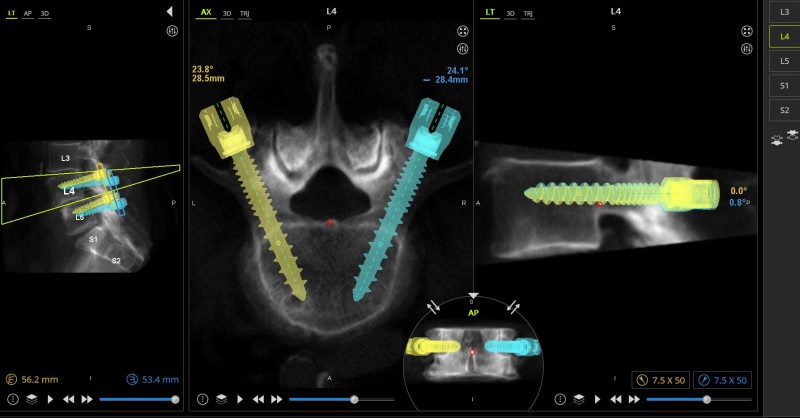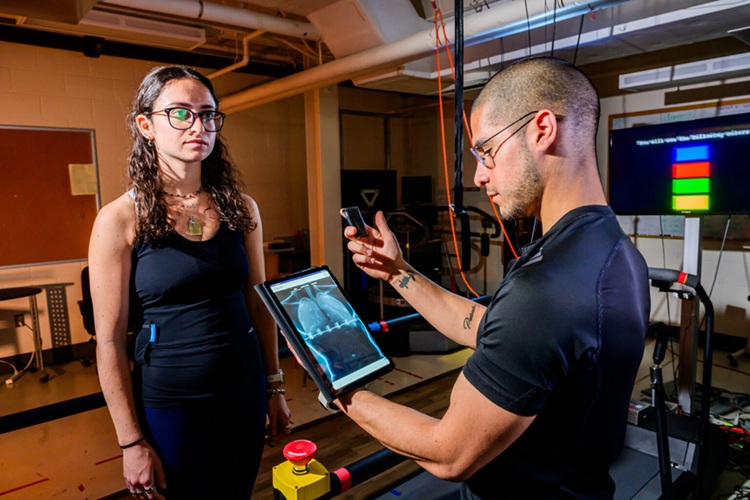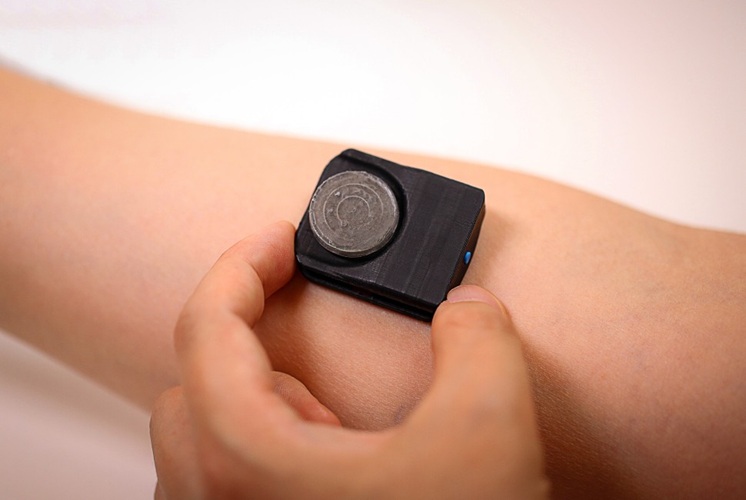Robotic-Assisted and AR Spine Surgery Enable Equally High Degree of Precision and Accuracy, Finds Study
|
By HospiMedica International staff writers Posted on 19 Dec 2024 |

Pedicle screws are commonly used in spinal surgeries to stabilize the spine, and accurate placement is essential for successful outcomes. In recent years, robotic-assisted navigation (RAN) and augmented reality (AR) systems have been developed for spine surgery. RAN involves using robotic arms to guide surgeon-operated instruments with the help of 3D imaging of the patient’s anatomy and GPS-like navigation technology, allowing for minimally invasive procedures planned in advance using specialized software. On the other hand, AR-assisted spine surgery overlays 3D images of a patient’s spine onto the surgeon’s view during surgery via an augmented reality headset, with the surgery being planned using preoperative CT scans. Now, a new study comparing these two techniques found that both RAN and AR provided excellent accuracy and safety for pedicle screw placement.
The study conducted by researchers at the Hospital for Special Surgery (HSS, New York, NY, USA) involved 212 adult patients undergoing spine surgery, where a total of 1,211 pedicle screws were placed using either RAN (827 screws in 108 patients) or AR (384 screws in 104 patients) between June 2020 and October 2023. The surgeries were performed on the lumbar and/or sacral spine to treat degenerative spinal conditions. One highly experienced surgeon performed all robotic-assisted cases, while two other skilled surgeons used the AR system for the remaining surgeries. The placement of each pedicle screw was assessed after surgery using either CT scans or 3D fluoroscopy, with accuracy graded using the Gertzbein-Robbins classification system, which categorizes screw placements as A, B, C, or D.
Grades A and B were considered acceptable, with Grade A representing a screw placed entirely within the pedicle, and Grade B indicating a screw that was 2mm (1/16 inch) outside the desired position. Grades C and D were deemed unacceptable. Two independent spine surgeons evaluated the screw placements, and no significant differences were found between the two techniques. In terms of accuracy, 99.6% of screws placed using RAN were rated Grade A or B, while 98.7% of AR-placed screws received the same rating. Overall, 92.6% of screws were classified as Grade A, indicating a high level of accuracy in both methods.
“Compared to conventional free-hand techniques, both robotic-assisted navigation and the use of augmented reality have demonstrated superior accuracy. Our study is the first to directly compare RAN to AR with respect to screw placement precision,” said Darren R. Lebl, MD, MBA, a spine surgeon and director of research at HSS, and principal investigator of the study. “Our results confirmed excellent accuracy for both techniques, making both robotics and AR safe tools for accurate positioning of lumbosacral pedicle screws. However, a higher rate of Grade A screws was seen in the RAN group, potentially highlighting superior precision for robotics.”
Related Links:
HSS
Latest Surgical Techniques News
- Intravascular Imaging for Guiding Stent Implantation Ensures Safer Stenting Procedures
- World's First AI Surgical Guidance Platform Allows Surgeons to Measure Success in Real-Time
- AI-Generated Synthetic Scarred Hearts Aid Atrial Fibrillation Treatment
- New Class of Bioadhesives to Connect Human Tissues to Long-Term Medical Implants
- New Transcatheter Valve Found Safe and Effective for Treating Aortic Regurgitation
- Minimally Invasive Valve Repair Reduces Hospitalizations in Severe Tricuspid Regurgitation Patients
- Tiny Robotic Tools Powered by Magnetic Fields to Enable Minimally Invasive Brain Surgery
- Magnetic Tweezers Make Robotic Surgery Safer and More Precise
- AI-Powered Surgical Planning Tool Improves Pre-Op Planning
- Novel Sensing System Restores Missing Sense of Touch in Minimally Invasive Surgery
- Headset-Based AR Navigation System Improves EVD Placement
- Higher Electrode Density Improves Epilepsy Surgery by Pinpointing Where Seizures Begin
- Open-Source Tool Optimizes Placement of Visual Brain Implants
- Easy-To-Apply Gel Could Prevent Formation of Post-Surgical Abdominal Adhesions
- Groundbreaking Leadless Pacemaker to Prevent Invasive Surgeries for Children
- Spectroscopy Technique Improves Surgery for Pediatric Epilepsy Patients
Channels
Critical Care
view channel
Novel Intrabronchial Method Delivers Cell Therapies in Critically Ill Patients on External Lung Support
Until now, administering cell therapies to patients on extracorporeal membrane oxygenation (ECMO)—a life-support system typically used for severe lung failure—has been nearly impossible.... Read more
Generative AI Technology Detects Heart Disease Earlier Than Conventional Methods
Detecting heart dysfunction early using cost-effective and widely accessible tools like electrocardiograms (ECGs) and efficiently directing the right patients for more expensive imaging tests remains a... Read more
Wearable Technology Predicts Cardiovascular Risk by Continuously Monitoring Heart Rate Recovery
The heart's response to physical activity is a vital early indicator of changes in health, particularly in cardiovascular function and mortality. Extensive research has demonstrated a connection between... Read more
Wearable Health Monitoring Device Measures Gases Emitted from and Absorbed by Skin
The skin plays a vital role in protecting our body from external elements. A key component of this protective function is the skin barrier, which consists of tightly woven proteins and fats that help retain... Read morePatient Care
view channel
Portable Biosensor Platform to Reduce Hospital-Acquired Infections
Approximately 4 million patients in the European Union acquire healthcare-associated infections (HAIs) or nosocomial infections each year, with around 37,000 deaths directly resulting from these infections,... Read moreFirst-Of-Its-Kind Portable Germicidal Light Technology Disinfects High-Touch Clinical Surfaces in Seconds
Reducing healthcare-acquired infections (HAIs) remains a pressing issue within global healthcare systems. In the United States alone, 1.7 million patients contract HAIs annually, leading to approximately... Read more
Surgical Capacity Optimization Solution Helps Hospitals Boost OR Utilization
An innovative solution has the capability to transform surgical capacity utilization by targeting the root cause of surgical block time inefficiencies. Fujitsu Limited’s (Tokyo, Japan) Surgical Capacity... Read more
Game-Changing Innovation in Surgical Instrument Sterilization Significantly Improves OR Throughput
A groundbreaking innovation enables hospitals to significantly improve instrument processing time and throughput in operating rooms (ORs) and sterile processing departments. Turbett Surgical, Inc.... Read moreHealth IT
view channel
Printable Molecule-Selective Nanoparticles Enable Mass Production of Wearable Biosensors
The future of medicine is likely to focus on the personalization of healthcare—understanding exactly what an individual requires and delivering the appropriate combination of nutrients, metabolites, and... Read more
Smartwatches Could Detect Congestive Heart Failure
Diagnosing congestive heart failure (CHF) typically requires expensive and time-consuming imaging techniques like echocardiography, also known as cardiac ultrasound. Previously, detecting CHF by analyzing... Read moreBusiness
view channel
Expanded Collaboration to Transform OR Technology Through AI and Automation
The expansion of an existing collaboration between three leading companies aims to develop artificial intelligence (AI)-driven solutions for smart operating rooms with sophisticated monitoring and automation.... Read more















